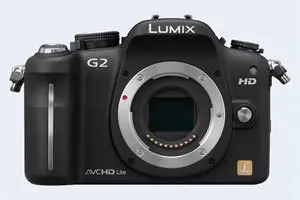Panasonic G2 vs Zeiss ZX1
The Panasonic Lumix DMC-G2 and the Zeiss ZX1 are two digital cameras that were officially introduced, respectively, in March 2010 and September 2018. The G2 is a mirrorless interchangeable lens camera, while the ZX1 is a fixed lens compact. The cameras are based on a Four Thirds (G2) and a full frame (ZX1) sensor. The Panasonic has a resolution of 12 megapixels, whereas the Zeiss provides 37.4 MP.
Below is an overview of the main specs of the two cameras as a starting point for the comparison.

Check G2 offers at
ebay.com

Check ZX1 offers at
ebay.com
Going beyond this snapshot of core features and characteristics, what are the differences between the Panasonic Lumix DMC-G2 and the Zeiss ZX1? Which one should you buy? Read on to find out how these two cameras compare with respect to their body size, their imaging sensors, their shooting features, their input-output connections, and their reception by expert reviewers.
Body comparison
The physical size and weight of the Panasonic G2 and the Zeiss ZX1 are illustrated in the side-by-side display below. The two cameras are presented according to their relative size. Three consecutive perspectives from the front, the top, and the back are available. All width, height and depth dimensions are rounded to the nearest millimeter.
The G2 can be obtained in three different colors (black, blue, red), while the ZX1 is only available in black.
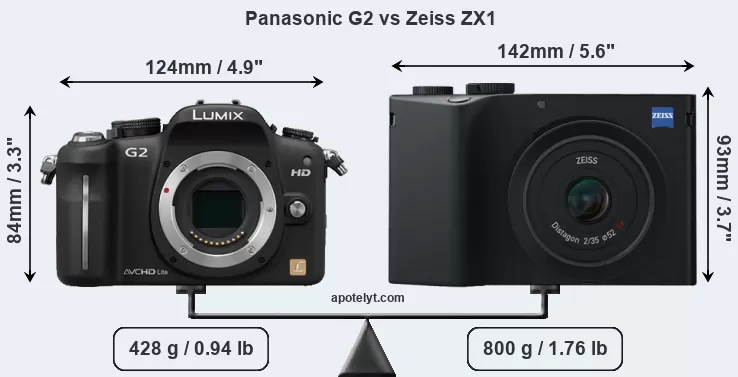
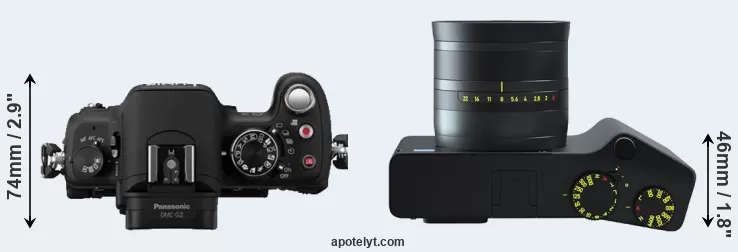
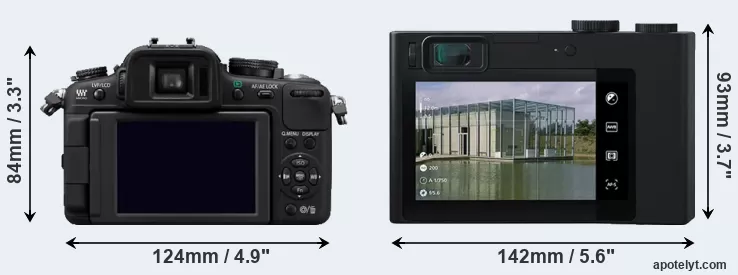
If the front view area (width x height) of the cameras is taken as an aggregate measure of their size, the Zeiss ZX1 is notably larger (27 percent) than the Panasonic G2. In this context, it is worth noting that neither the G2 nor the ZX1 are weather-sealed.
The above size and weight comparisons are to some extent incomplete and possibly misleading, as the ZX1 has a lens built in, whereas the G2 is an interchangeable lens camera that requires a separate lens. Attaching the latter will add extra weight and bulk to the setup. You can compare the optics available for the G2 and their specifications in the Micro Four Thirds Lens Catalog.
Concerning battery life, the G2 gets 360 shots out of its Panasonic DMW-BLB13 battery, while the ZX1 can take 250 images on a single charge of its Zeiss DD-PS1A power pack.
The following table provides a synthesis of the main physical specifications of the two cameras and other similar ones. In case you want to display and compare another camera duo, you can use the CAM-parator app to select your camera combination among a large number of options.

| Camera Model |
Camera Width |
Camera Height |
Camera Depth |
Camera Weight |
Battery Life |
Weather Sealing |
Camera Launch |
Launch Price (USD) |
Street Price |
||
|---|---|---|---|---|---|---|---|---|---|---|---|
| 1. | Panasonic G2 | 124 mm | 84 mm | 74 mm | 428 g | 360 | n | Mar 2010 | 599 | ebay.com | |
| 2. | Zeiss ZX1 | 142 mm | 93 mm | 46 mm | 800 g | 250 | n | Sep 2018 | 5,999 | ebay.com | |
| 3. | Leica M10 | 139 mm | 80 mm | 39 mm | 660 g | 210 | Y | Jan 2017 | 6,595 | ebay.com | |
| 4. | Leica Q Typ 116 | 130 mm | 80 mm | 93 mm | 640 g | 300 | n | Jun 2015 | 4,249 | ebay.com | |
| 5. | Leica Q2 | 130 mm | 80 mm | 92 mm | 718 g | 370 | Y | Mar 2019 | 4,995 | amazon.com | |
| 6. | Olympus E-PL2 | 114 mm | 72 mm | 42 mm | 362 g | 280 | n | Jan 2011 | 599 | ebay.com | |
| 7. | Panasonic FZ1000 | 137 mm | 99 mm | 131 mm | 831 g | 360 | n | Jun 2014 | 899 | ebay.com | |
| 8. | Panasonic G1 | 124 mm | 84 mm | 45 mm | 360 g | 410 | n | Sep 2008 | 599 | ebay.com | |
| 9. | Panasonic G3 | 115 mm | 84 mm | 47 mm | 336 g | 270 | n | May 2011 | 599 | ebay.com | |
| 10. | Panasonic G10 | 124 mm | 84 mm | 74 mm | 388 g | 380 | n | Mar 2010 | 499 | ebay.com | |
| 11. | Panasonic GF1 | 119 mm | 71 mm | 36 mm | 385 g | 380 | n | Sep 2009 | 749 | ebay.com | |
| 12. | Panasonic GF2 | 113 mm | 68 mm | 33 mm | 310 g | 300 | n | Nov 2010 | 549 | ebay.com | |
| 13. | Panasonic GF3 | 108 mm | 67 mm | 32 mm | 264 g | 300 | n | Jun 2011 | 549 | ebay.com | |
| 14. | Panasonic GF5 | 108 mm | 67 mm | 37 mm | 267 g | 360 | n | Apr 2012 | 499 | ebay.com | |
| 15. | Panasonic GH1 | 124 mm | 90 mm | 45 mm | 385 g | 300 | n | Mar 2009 | 899 | ebay.com | |
| 16. | Panasonic GH2 | 124 mm | 90 mm | 76 mm | 442 g | 330 | n | Sep 2010 | 899 | ebay.com | |
| 17. | Sony RX1R II | 113 mm | 65 mm | 72 mm | 507 g | 220 | n | Oct 2015 | 3,299 | ebay.com | |
| Note: Measurements and pricing do not include easily detachable parts, such as add-on or interchangeable lenses or optional viewfinders. | |||||||||||
The price is, of course, an important factor in any camera decision. The manufacturer’s suggested retail prices give an idea on the placement of the camera in the maker’s lineup and the broader market. Usually, retail prices stay at first close to the launch price, but after several months, discounts become available. Later in the product cycle and, in particular, when the replacement model is about to appear, further discounting and stock clearance sales often push the camera price considerably down. Then, after the new model is out, very good deals can frequently be found on the pre-owned market.
Sensor comparison
The size of the sensor inside a digital camera is one of the key determinants of image quality. A large sensor will tend to have larger individual pixels that provide better low-light sensitivity, wider dynamic range, and richer color-depth than smaller pixel-units in a sensor of the same technological generation. Moreover, a large sensor camera will give the photographer more control over depth-of-field in the image and, thus, the ability to better isolate a subject from the background. On the downside, larger sensors are more costly to manufacture and tend to lead to bigger and heavier cameras and lenses.
Of the two cameras under consideration, the Panasonic G2 features a Four Thirds sensor and the Zeiss ZX1 a full frame sensor. The sensor area in the ZX1 is 284 percent bigger. As a result of these sensor size differences, the cameras have a format factor of, respectively, 2.0 and 1.0. The sensor in the G2 has a native 4:3 aspect ratio, while the one in the ZX1 offers a 3:2 aspect.
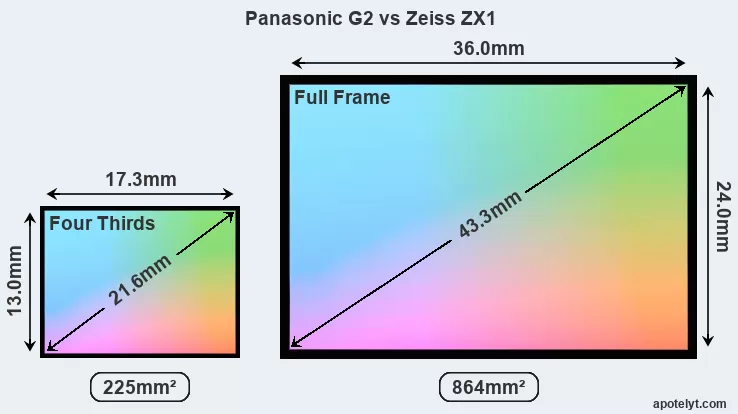
With 37.4MP, the ZX1 offers a higher resolution than the G2 (12MP), but the ZX1 nevertheless has larger individual pixels (pixel pitch of 4.81μm versus 4.33μm for the G2) due to its larger sensor. Moreover, the ZX1 is a much more recent model (by 8 years and 6 months) than the G2, and its sensor will have benefitted from technological advances during this time that further enhance the light gathering capacity of its pixel-units.
The resolution advantage of the Zeiss ZX1 implies greater flexibility for cropping images or the possibility to print larger pictures. The maximum print size of the ZX1 for good quality output (200 dots per inch) amounts to 37.4 x 25 inches or 95.1 x 63.4 cm, for very good quality (250 dpi) 30 x 20 inches or 76.1 x 50.7 cm, and for excellent quality (300 dpi) 25 x 16.6 inches or 63.4 x 42.3 cm. The corresponding values for the Panasonic G2 are 20 x 15 inches or 50.8 x 38.1 cm for good quality, 16 x 12 inches or 40.6 x 30.5 cm for very good quality, and 13.3 x 10 inches or 33.9 x 25.4 cm for excellent quality prints.
The Panasonic Lumix DMC-G2 has a native sensitivity range from ISO 100 to ISO 6400. The corresponding ISO settings for the Zeiss ZX1 are ISO 80 to ISO 51200 (no boost).
Technology-wise, both cameras are equipped with CMOS (Complementary Metal–Oxide–Semiconductor) sensors. Both cameras use a Bayer filter for capturing RGB colors on a square grid of photosensors. This arrangement is found in most digital cameras.
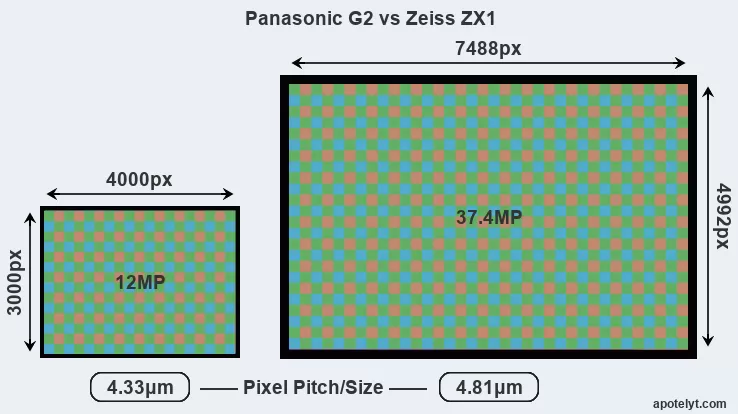
Consistent information on actual sensor performance is available from DXO Mark for many cameras. This service assesses and scores the color depth ("DXO Portrait"), dynamic range ("DXO Landscape"), and low-light sensitivity ("DXO Sports") of camera sensors, and also publishes an overall camera score. The following table provides an overview of the physical sensor characteristics, as well as the sensor quality measurements for a selection of comparators.

| Camera Model |
Sensor Class |
Resolution (MP) |
Horiz. Pixels |
Vert. Pixels |
Video Format |
DXO Portrait |
DXO Landscape |
DXO Sports |
DXO Overall |
||
|---|---|---|---|---|---|---|---|---|---|---|---|
| 1. | Panasonic G2 | Four Thirds | 12.0 | 4000 | 3000 | 720/30p | 21.2 | 10.3 | 493 | 53 | |
| 2. | Zeiss ZX1 | Full Frame | 37.4 | 7488 | 4992 | 4K/30p | 25.2 | 14.1 | 2759 | 94 | |
| 3. | Leica M10 | Full Frame | 23.8 | 5952 | 3992 | none | 24.4 | 13.2 | 2133 | 86 | |
| 4. | Leica Q Typ 116 | Full Frame | 24.0 | 6000 | 4000 | 1080/60p | 24.3 | 12.7 | 2221 | 85 | |
| 5. | Leica Q2 | Full Frame | 46.7 | 8368 | 5584 | 4K/30p | 26.4 | 13.5 | 2491 | 96 | |
| 6. | Olympus E-PL2 | Four Thirds | 12.2 | 4032 | 3024 | 720/30p | 21.4 | 10.2 | 573 | 55 | |
| 7. | Panasonic FZ1000 | 1-inch | 20.0 | 5472 | 3648 | 4K/30p | 22.1 | 11.7 | 517 | 64 | |
| 8. | Panasonic G1 | Four Thirds | 12.0 | 4000 | 3000 | none | 21.1 | 10.3 | 463 | 53 | |
| 9. | Panasonic G3 | Four Thirds | 15.8 | 4592 | 3448 | 1080/60i | 21.0 | 10.6 | 667 | 56 | |
| 10. | Panasonic G10 | Four Thirds | 12.0 | 4000 | 3000 | 720/30p | 21.2 | 10.1 | 411 | 52 | |
| 11. | Panasonic GF1 | Four Thirds | 12.0 | 4000 | 3000 | 720/30p | 21.2 | 10.3 | 513 | 54 | |
| 12. | Panasonic GF2 | Four Thirds | 12.0 | 4000 | 3000 | 1080/60i | 21.2 | 10.3 | 506 | 54 | |
| 13. | Panasonic GF3 | Four Thirds | 12.0 | 4000 | 3000 | 1080/60i | 20.6 | 10.1 | 459 | 50 | |
| 14. | Panasonic GF5 | Four Thirds | 12.0 | 4000 | 3000 | 1080/60i | 20.5 | 10.0 | 573 | 50 | |
| 15. | Panasonic GH1 | Four Thirds | 12.0 | 4000 | 3000 | 1080/24p | 21.6 | 11.6 | 772 | 64 | |
| 16. | Panasonic GH2 | Four Thirds | 15.9 | 4608 | 3456 | 1080/60i | 21.2 | 11.3 | 655 | 60 | |
| 17. | Sony RX1R II | Full Frame | 42.2 | 7952 | 5304 | 1080/60p | 25.8 | 13.9 | 3204 | 97 | |
| Note: DXO values in italics represent estimates based on sensor size and age. | |||||||||||
Many modern cameras are not only capable of taking still images, but also of capturing video footage. Both cameras under consideration are equipped with sensors that have a sufficiently high read-out speed for moving images, but the ZX1 provides a better video resolution than the G2. It can shoot movie footage at 4K/30p, while the Panasonic is limited to 720/30p.
Feature comparison
Apart from body and sensor, cameras can and do differ across a variety of features. The two cameras under review are similar with respect to both having an electronic viewfinder. However, the one in the ZX1 offers a substantially higher resolution than the one in the G2 (6221k vs 1440k dots). The adjacent table lists some of the other core features of the Panasonic G2 and Zeiss ZX1 along with similar information for a selection of comparators.

| Camera Model |
Viewfinder (Type or 000 dots) |
Control Panel (yes/no) |
LCD Specifications (inch/000 dots) |
LCD Attach- ment |
Touch Screen (yes/no) |
Max Shutter Speed * |
Max Shutter Flaps * |
Built-in Flash (yes/no) |
Built-in Image Stab |
||
|---|---|---|---|---|---|---|---|---|---|---|---|
| 1. | Panasonic G2 | 1440 | n | 3.0 / 460 | swivel | Y | 1/4000s | 2.6/s | Y | n | |
| 2. | Zeiss ZX1 | 6221 | n | 4.3 / 2765 | fixed | Y | 1/1000s | 3.0/s | n | n | |
| 3. | Leica M10 | optical | n | 3.0 / 1037 | fixed | n | 1/4000s | 5.0/s | n | n | |
| 4. | Leica Q Typ 116 | 3680 | n | 3.0 / 1040 | fixed | Y | 1/2000s | 10.0/s | n | Y | |
| 5. | Leica Q2 | 3680 | n | 3.0 / 1040 | fixed | Y | 1/2000s | 10.0/s | n | Y | |
| 6. | Olympus E-PL2 | optional | n | 3.0 / 460 | fixed | n | 1/4000s | 3.0/s | Y | Y | |
| 7. | Panasonic FZ1000 | 2359 | n | 3.0 / 921 | swivel | n | 1/4000s | 12.0/s | Y | Y | |
| 8. | Panasonic G1 | 1440 | n | 3.0 / 460 | swivel | n | 1/4000s | 3.0/s | Y | n | |
| 9. | Panasonic G3 | 1440 | n | 3.0 / 460 | swivel | Y | 1/4000s | 4.0/s | Y | n | |
| 10. | Panasonic G10 | 202 | n | 3.0 / 460 | fixed | n | 1/4000s | 2.6/s | Y | n | |
| 11. | Panasonic GF1 | optional | n | 3.0 / 460 | fixed | n | 1/4000s | 3.0/s | Y | n | |
| 12. | Panasonic GF2 | optional | n | 3.0 / 460 | fixed | Y | 1/4000s | 2.6/s | Y | n | |
| 13. | Panasonic GF3 | none | n | 3.0 / 460 | fixed | Y | 1/4000s | 3.2/s | Y | n | |
| 14. | Panasonic GF5 | none | n | 3.0 / 920 | fixed | Y | 1/4000s | 4.0/s | Y | n | |
| 15. | Panasonic GH1 | 1440 | n | 3.0 / 460 | swivel | n | 1/4000s | 3.0/s | Y | n | |
| 16. | Panasonic GH2 | 1534 | n | 3.0 / 460 | swivel | n | 1/4000s | 3.0/s | Y | n | |
| 17. | Sony RX1R II | 2360 | n | 3.0 / 1229 | tilting | n | 1/4000s | 5.0/s | n | n | |
| Note: *) Information refers to the mechanical shutter, unless the camera only has an electronic one. | |||||||||||
One difference between the cameras concerns the presence of an on-board flash. The G2 has one, while the ZX1 does not. While the built-in flash of the G2 is not very powerful, it can at times be useful as a fill-in light.
The G2 has an articulated LCD that can be turned to be front-facing. This characteristic will be appreciated by vloggers and photographers who are interested in snapping selfies. In contrast, the ZX1 does not have a selfie-screen.The reported shutter speed information refers to the use of the mechanical shutter. Yet, some cameras only have an electronic shutter, while others have an electronic shutter in addition to a mechanical one. In fact, the ZX1 is one of those camera that have an additional electronic shutter, which makes completely silent shooting possible. However, this mode is less suitable for photographing moving objects (risk of rolling shutter) or shooting under artificial light sources (risk of flickering).
The G2 writes its imaging data to SDXC cards, while the ZX1 uses an internal SSD.
Connectivity comparison
For some imaging applications, the extent to which a camera can communicate with its environment can be an important aspect in the camera decision process. The table below provides an overview of the connectivity of the Panasonic Lumix DMC-G2 and Zeiss ZX1 and, in particular, the interfaces the cameras (and selected comparators) provide for accessory control and data transfer.

| Camera Model |
Hotshoe Port |
Internal Mic / Speaker |
Microphone Port |
Headphone Port |
HDMI Port |
USB Port |
WiFi Support |
NFC Support |
Bluetooth Support |
||
|---|---|---|---|---|---|---|---|---|---|---|---|
| 1. | Panasonic G2 | Y | stereo / mono | - | - | mini | 2.0 | - | - | - | |
| 2. | Zeiss ZX1 | Y | stereo / mono | - | - | - | 3.1 | Y | Y | Y | |
| 3. | Leica M10 | Y | - / - | - | - | - | - | Y | - | - | |
| 4. | Leica Q Typ 116 | Y | stereo / mono | - | - | micro | 2.0 | Y | Y | - | |
| 5. | Leica Q2 | Y | stereo / mono | - | - | - | - | Y | - | Y | |
| 6. | Olympus E-PL2 | Y | stereo / - | - | - | mini | 2.0 | - | - | - | |
| 7. | Panasonic FZ1000 | Y | stereo / mono | Y | - | micro | 2.0 | Y | Y | - | |
| 8. | Panasonic G1 | Y | - / - | - | - | mini | 2.0 | - | - | - | |
| 9. | Panasonic G3 | Y | stereo / mono | - | - | mini | 2.0 | - | - | - | |
| 10. | Panasonic G10 | Y | mono / - | - | - | mini | 2.0 | - | - | - | |
| 11. | Panasonic GF1 | Y | mono / mono | - | - | mini | 2.0 | - | - | - | |
| 12. | Panasonic GF2 | Y | stereo / mono | - | - | mini | 2.0 | - | - | - | |
| 13. | Panasonic GF3 | - | stereo / mono | - | - | mini | 2.0 | - | - | - | |
| 14. | Panasonic GF5 | - | stereo / mono | - | - | mini | 2.0 | - | - | - | |
| 15. | Panasonic GH1 | Y | stereo / - | Y | - | mini | 2.0 | - | - | - | |
| 16. | Panasonic GH2 | Y | stereo / mono | Y | - | mini | 2.0 | - | - | - | |
| 17. | Sony RX1R II | Y | stereo / mono | Y | - | micro | 2.0 | Y | Y | - |
It is notable that the ZX1 offers wifi support, which can be a very convenient means to transfer image data to an off-camera location. In contrast, the G2 does not provide wifi capability.
Both the G2 and the ZX1 have been discontinued, but can regularly be found used on ebay. The G2 was replaced by the Panasonic G3, while the ZX1 does not have a direct successor. Further information on the features and operation of the G2 and ZX1 can be found, respectively, in the Panasonic G2 Manual (free pdf) or the online Zeiss ZX1 Manual.
Review summary
So what is the bottom line? Which of the two cameras – the Panasonic G2 or the Zeiss ZX1 – has the upper hand? Is one clearly better than the other? A synthesis of the relative strong points of each of the models is listed below.

Arguments in favor of the Panasonic Lumix DMC-G2:
- More flexible LCD: Has a swivel screen for odd-angle shots in portrait or landscape orientation.
- More selfie-friendly: Has an articulated screen that can be turned to be front-facing.
- Faster shutter: Has higher mechanical shutter speed (1/4000s vs 1/1000s) to freeze action.
- More flexible: Accepts interchangeable lenses, so that lens characteristics can be altered.
- More compact: Is smaller (124x84mm vs 142x93mm) and thus needs less room in the bag.
- Longer lasting: Can take more shots (360 versus 250) on a single battery charge.
- Easier fill-in: Is equipped with a small onboard flash to brighten deep shadow areas.
- More heavily discounted: Has been available for much longer (launched in March 2010).

Advantages of the Zeiss ZX1:
- More detail: Has more megapixels (37.4 vs 12MP), which boosts linear resolution by 80%.
- Better image quality: Is equipped with a larger and more technologically advanced sensor.
- Richer colors: The sensor size advantage translates into images with better, more accurate colors.
- More dynamic range: Larger sensor captures a wider spectrum of light and dark details.
- Better low-light sensitivity: Larger sensor produces good images even in poorly lit environments.
- Better video: Provides higher definition movie capture (4K/30p vs 720/30p).
- More detailed viewfinder: Has higher resolution electronic viewfinder (6221k vs 1440k dots).
- Larger viewfinder image: Features a viewfinder with a higher magnification (0.74x vs 0.70x).
- Larger screen: Has a bigger rear LCD (4.3" vs 3.0") for image review and settings control.
- More detailed LCD: Has a higher resolution rear screen (2765k vs 460k dots).
- Faster burst: Shoots at higher frequency (3 vs 2.6 flaps/sec) to capture the decisive moment.
- Less disturbing: Has an electronic shutter option for completely silent shooting.
- Ready to shoot: Has an integrated lens, whereas the G2 necessitates an extra lens.
- Faster data transfer: Supports a more advanced USB protocol (3.1 vs 2.0).
- Easier file upload: Has wifi built in for automatic backup or image transfer to the web.
- Easier device pairing: Supports NFC for fast wireless image transfer over short distances.
- Easier wireless transfer: Supports Bluetooth for image sharing without cables.
- More prestigious: Has the Zeiss luxury appeal, which ensures a high resale value.
- More modern: Reflects 8 years and 6 months of technical progress since the G2 launch.
If the count of individual advantages (bullet points above) is taken as a guide, the ZX1 is the clear winner of the contest (19 : 8 points). However, the pertinence of the various camera strengths will differ across photographers, so that you might want to weigh individual camera traits according to their importance for your own imaging needs before making a camera decision. A professional wedding photographer will view the differences between cameras in a way that diverges from the perspective of a travel photog, and a person interested in cityscapes has distinct needs from a macro shooter. Hence, the decision which camera is best and worth buying is often a very personal one.
How about other alternatives? Do the specifications of the Panasonic G2 and the Zeiss ZX1 place the cameras among the top in their class? Find out in the latest Best Mirrorless Interchangeable Lens Camera and Best Prime Lens Compact Camera listings whether the two cameras rank among the cream of the crop.
In any case, while the comparison of the spec-sheets of cameras can offer a general idea of their imaging potential, it says little about, for example, the shooting experience and imaging performance of the G2 and the ZX1 in practical situations. User reviews, such as those found at amazon, can sometimes inform about these issues, but such feedback is often incomplete, inconsistent, and biased.
Expert reviews
This is why expert reviews are important. The table below provides a synthesis of the camera assessments of some of the best known photo-gear review sites (amateurphotographer [AP], cameralabs [CL], digitalcameraworld [DCW], dpreview [DPR], ephotozine [EPZ], photographyblog [PB]). As can be seen, the professional reviewers agree in many cases on the quality of different cameras, but sometimes their assessments diverge, reinforcing the earlier point that a camera decision is often a very personal choice.

| Camera Model |
AP score |
CL score |
DCW score |
DPR score |
EPZ score |
PB score |
Camera Launch |
Launch Price (USD) |
Street Price |
||
|---|---|---|---|---|---|---|---|---|---|---|---|
| 1. | Panasonic G2 | .. | .. | .. | 72/100 | 4/5 | 4.5/5 | Mar 2010 | 599 | ebay.com | |
| 2. | Zeiss ZX1 | 3/5 | .. | .. | 83/100 | 4/5 | 4/5 | Sep 2018 | 5,999 | ebay.com | |
| 3. | Leica M10 | 4.5/5 | .. | .. | .. | 4/5 | 4.5/5 | Jan 2017 | 6,595 | ebay.com | |
| 4. | Leica Q Typ 116 | 5/5 | .. | .. | 80/100 | 4.5/5 | 4.5/5 | Jun 2015 | 4,249 | ebay.com | |
| 5. | Leica Q2 | .. | .. | 4.5/5 | 84/100 | 4.5/5 | 4/5 | Mar 2019 | 4,995 | amazon.com | |
| 6. | Olympus E-PL2 | 3/5 | 83/100 | .. | 71/100 | 4.5/5 | 4.5/5 | Jan 2011 | 599 | ebay.com | |
| 7. | Panasonic FZ1000 | 4/5 | + + | .. | 82/100 | 4.5/5 | 4.5/5 | Jun 2014 | 899 | ebay.com | |
| 8. | Panasonic G1 | .. | + + | .. | 70/100 | 4/5 | 4.5/5 | Sep 2008 | 599 | ebay.com | |
| 9. | Panasonic G3 | 3/5 | + + | .. | 75/100 | 4.5/5 | 5/5 | May 2011 | 599 | ebay.com | |
| 10. | Panasonic G10 | 3/5 | .. | .. | 70/100 | 4/5 | 4/5 | Mar 2010 | 499 | ebay.com | |
| 11. | Panasonic GF1 | .. | 85/100 | .. | 69/100 | 4.5/5 | 4.5/5 | Sep 2009 | 749 | ebay.com | |
| 12. | Panasonic GF2 | 3/5 | 82/100 | .. | 70/100 | 4.5/5 | 4.5/5 | Nov 2010 | 549 | ebay.com | |
| 13. | Panasonic GF3 | 3/5 | 82/100 | .. | 71/100 | 4.5/5 | 4/5 | Jun 2011 | 549 | ebay.com | |
| 14. | Panasonic GF5 | 3/5 | .. | .. | .. | 4.5/5 | 4.5/5 | Apr 2012 | 499 | ebay.com | |
| 15. | Panasonic GH1 | .. | + + | .. | 72/100 | 4.5/5 | 4.5/5 | Mar 2009 | 899 | ebay.com | |
| 16. | Panasonic GH2 | 5/5 | + + | .. | 79/100 | 4.5/5 | 5/5 | Sep 2010 | 899 | ebay.com | |
| 17. | Sony RX1R II | 5/5 | .. | .. | 82/100 | .. | 4.5/5 | Oct 2015 | 3,299 | ebay.com | |
| Note: (+ +) highly recommended; (+) recommended; (o) reviewed; (..) not available. | |||||||||||
The above review scores should be interpreted with care, though. The ratings are only valid when referring to cameras in the same category and of the same age. A score, therefore, has to be seen in close connection to the price and market introduction time of the camera, and comparisons of ratings among very different cameras or across long time periods have little meaning. It should also be noted that some of the review sites have over time altered the way they render their verdicts.

Check G2 offers at
ebay.com

Check ZX1 offers at
ebay.com
Other camera comparisons
Did this review help to inform your camera decision process? In case you are interested in seeing how other cameras pair up, just make your choice using the following search menu. As an alternative, you can also directly jump to any one of the listed comparisons that were previously generated by the CAM-parator tool.
- Canon 200D vs Zeiss ZX1
- Canon G16 vs Zeiss ZX1
- Canon M6 Mark II vs Panasonic G2
- Leica S Typ 007 vs Zeiss ZX1
- Nikon D5 vs Zeiss ZX1
- Nikon D5600 vs Panasonic G2
- Nikon D7000 vs Panasonic G2
- Nikon D7500 vs Zeiss ZX1
- Olympus TG-5 vs Zeiss ZX1
- Panasonic FZ2000 vs Panasonic G2
- Panasonic G2 vs Sony A3000
- Panasonic G2 vs Sony RX100 II
Specifications: Panasonic G2 vs Zeiss ZX1
Below is a side-by-side comparison of the specs of the two cameras to facilitate a quick review of their differences and common features.
| Camera Model | Panasonic G2 | Zeiss ZX1 |
|---|---|---|
| Camera Type | Mirrorless system camera | Fixed lens compact camera |
| Camera Lens | Micro Four Thirds lenses | 35mm f/2.8 |
| Launch Date | March 2010 | September 2018 |
| Launch Price | USD 599 | USD 5,999 |
| Sensor Specs | Panasonic G2 | Zeiss ZX1 |
| Sensor Technology | CMOS | CMOS |
| Sensor Format | Four Thirds Sensor | Full Frame Sensor |
| Sensor Size | 17.3 x 13.0 mm | 36.0 x 24.0 mm |
| Sensor Area | 224.9 mm2 | 864 mm2 |
| Sensor Diagonal | 21.6 mm | 43.3 mm |
| Crop Factor | 2.0x | 1.0x |
| Sensor Resolution | 12 Megapixels | 37.4 Megapixels |
| Image Resolution | 4000 x 3000 pixels | 7488 x 4992 pixels |
| Pixel Pitch | 4.33 μm | 4.81 μm |
| Pixel Density | 5.34 MP/cm2 | 4.33 MP/cm2 |
| Moiré control | Anti-Alias filter | Anti-Alias filter |
| Movie Capability | 720/30p Video | 4K/30p Video |
| ISO Setting | 100 - 6,400 ISO | 80 - 51,200 ISO |
| DXO Sensor Quality (score) | 53 | .. |
| DXO Color Depth (bits) | 21.2 | .. |
| DXO Dynamic Range (EV) | 10.3 | .. |
| DXO Low Light (ISO) | 493 | .. |
| Screen Specs | Panasonic G2 | Zeiss ZX1 |
| Viewfinder Type | Electronic viewfinder | Electronic viewfinder |
| Viewfinder Field of View | 100% | 100% |
| Viewfinder Magnification | 0.70x | 0.74x |
| Viewfinder Resolution | 1440k dots | 6221k dots |
| LCD Framing | Live View | Live View |
| Rear LCD Size | 3.0inch | 4.3inch |
| LCD Resolution | 460k dots | 2765k dots |
| LCD Attachment | Swivel screen | Fixed screen |
| Touch Input | Touchscreen | Touchscreen |
| Shooting Specs | Panasonic G2 | Zeiss ZX1 |
| Focus System | Contrast-detect AF | Contrast-detect AF |
| Continuous Shooting | 2.6 shutter flaps/s | 3 shutter flaps/s |
| Electronic Shutter | no E-Shutter | up to 1/8000s |
| Fill Flash | Built-in Flash | no On-Board Flash |
| Storage Medium | SDXC cards | SSD cards |
| Single or Dual Card Slots | Single card slot | Single SSD |
| Connectivity Specs | Panasonic G2 | Zeiss ZX1 |
| External Flash | Hotshoe | Hotshoe |
| USB Connector | USB 2.0 | USB 3.1 |
| HDMI Port | mini HDMI | no HDMI |
| Wifi Support | no Wifi | Wifi built-in |
| Near-Field Communication | no NFC | NFC built-in |
| Bluetooth Support | no Bluetooth | Bluetooth built-in |
| Body Specs | Panasonic G2 | Zeiss ZX1 |
| Battery Type | Panasonic DMW-BLB13 | Zeiss DD-PS1A |
| Battery Life (CIPA) | 360 shots per charge | 250 shots per charge |
| Body Dimensions |
124 x 84 x 74 mm (4.9 x 3.3 x 2.9 in) |
142 x 93 x 46 mm (5.6 x 3.7 x 1.8 in) |
| Camera Weight | 428 g (15.1 oz) | 800 g (28.2 oz) |

Check G2 offers at
ebay.com

Check ZX1 offers at
ebay.com
Did you notice an error on this page? If so, please get in touch, so that we can correct the information.
